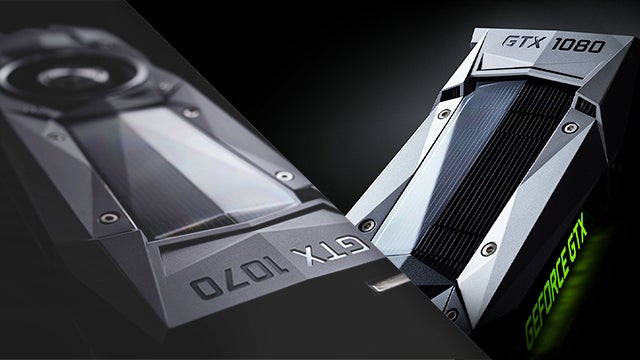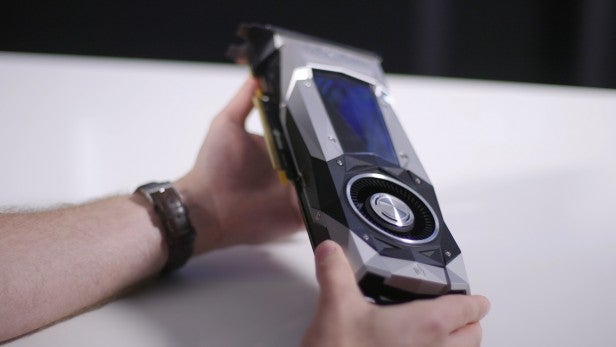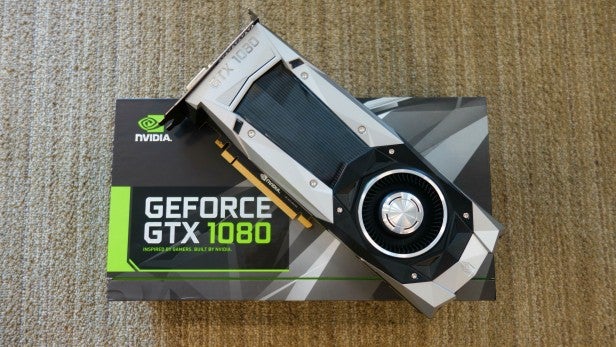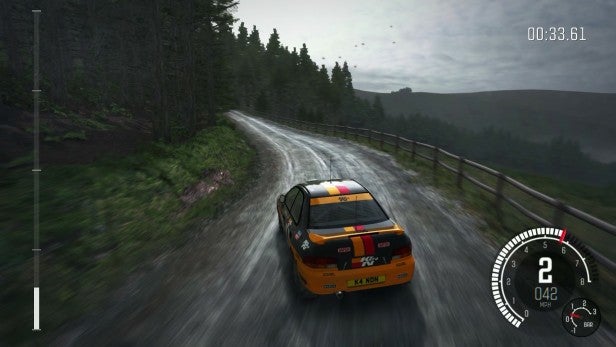Nvidia GeForce GTX 1080 vs 1070: Which is right for you?

There’s no doubt that Nvidia is raising its game when it comes to high-end graphics. Both of its recent releases have been barnstormers, and there’s certainly no question over where you should look if you’re searching for an enthusiast GPU.
At the top end, the choice isn’t between Nvidia or AMD, but which GeForce card to opt for. There’s the flagship GTX 1080, which deploys the full clout of the Pascal architecture – but it costs almost £600. If your pockets aren’t that deep then there’s the GTX 1070, which comes in at a more palatable £380 – but it isn’t as powerful.
TrustedReviews put both of these GPUs through a comprehensive set of benchmarks to find out which is best – and I’ve taken a deep dive into board partner cards, prices and overclocking too. Of course, you know which is the more powerful of the two, but hopefully the comparisons outlined below will help you to decide which card is best for your needs. Let’s get started.
If you want to read our individual reviews, you can click here for the GTX 1080 and GTX 1070 reviews.
Video: Nvidia GeForce GTX 1080 review
Nvidia GeForce GTX 1070 vs 1080 – Specs and Technology
The two GTX cards share the same architecture, but they’re designed for different scenarios. The range-topping GTX 1080 is built for 4K, multi-monitor and VR. The GTX 1070 has enough grunt to handle VR and 1440 playback, but it isn’t quite good enough for smooth 4K gaming.
Th Pascal architecture around which both cards are based is a remarkable bit of design. Nvidia has slimmed down its manufacturing process from 28nm to 16nm, a shrinkage that has allowed the firm to fit more transistors into smaller spaces – and to deploy them on fins, rather than on mere horizontal planes.
The result is that Nvidia is achieving far more with much less: the firm’s new cards include millions more transistors than previous GPUs, and on significantly smaller bits of silicon.
The smoother flow of electricity allows for better GPU performance alongside surprisingly low power consumption. The two new cards deploy 7.2 billion transistors on a 314mm2 die, with peak power consumption figures of 150W and 180W. Their predecessors used 5.2 billion transistors on a 398mm2 die and drew a peak of 145W and 165W from the mains.
Related: The best gaming PC specs to build yourself from £500
The GTX 1080 tops the range with 2,560 CUDA cores, while the GTX 1070 arrives with 1,920. Both cards tower over their predecessors: the GTX 980 had 2,048, while the GTX 970 had 1,664.
Video: Nvidia GeForce GTX 1070 review
The clock speeds are given a huge boost, too. The GTX 1080 zips along at 1,607MHz and the GTX 1070 is just 101MHz slower – both figures are hundreds of megahertz ahead of last year’s cards.
The shared architecture across the cards mean they share Nvidia’s new software features. One of the key inclusions is “pre-emption”, which allows Nvidia’s card to pick and choose between graphics and computing workloads simultaneously.
Both cards also have Lens Matched Shading, which saves resources by not rendering pixels that won’t be seen by the user. There’s simultaneous multi-projection, which allows the GPU to render a scene in as many as 16 different viewpoints – a boon for VR.
Related: Best graphics cards to buy
Many of these features won’t be used to their full potential right now, but future games development will no doubt take advantage, especially when APIs such as DirectX 12 and Vulkan are better supported.
The two cards diverge in the memory department. The GTX 1080 has 8GB of GDDR5X memory, while the GTX 1070 has 8GB of bog-standard GDDR5 RAM. The former memory is faster, with a 10,000MHz clock compared to the 8,000MHz in the GTX 1070. The GDDR5X memory has a 320-bit bus – wider than the 256-bit included on the GTX 1070.
Nvidia GeForce GTX 1070 vs 1080 – Testing Methodology
I benchmarked the GTX 1070 and GTX 1080 on TrustedReviews’ test rig, which has been designed to match the specifications of a standard enthusiast gaming PC. It features the following components:
- Motherboard: Asus Z170-Deluxe
- Processor: Intel Core i5-6600K (not overclocked)
- RAM: Corsair Vengeance 2666MHz, 16GB DDR4
- Cooler: Corsair H60 liquid cooler
- PSU: Corsair CX750M
- SSD: Samsung 850 EVO
- OS: Windows 10 Pro 64-bit
I’ve tested these powerful cards with five different games. Each title is run at its highest settings, and I’ve tested each game at 1,920 x 1,080, 2,560 x 1,440 and 3,840 x 2,160 – 4K.
I’ve also used a selection of synthetic benchmarks, with 3DMark’s demanding Fire Strike test alongside benchmarks to measure power consumption and peak temperature.
DiRT Rally
Ultra at 1,920 x 1,080 average
GTX 1070: 134.7
GTX 1080: 154.8
Ultra at 2,560 x 1,440, average
GTX 1070: 97.4
GTX 1080: 122.07
Ultra at 3,840 x 2,160, average
GTX 1070: 52.5
GTX 1080: 63.2
There’s no denying that the GTX 1080 is faster than the GTX 1070, but there’s also no denying that both cards have the power to play DiRT Rally at any resolution.
That’s no surprise, though: this is the easiest benchmark in the slate of test games. It’s fully representative of gameplay, and tests a GPU with complex lighting and rapid texture movement.

Both cards destroyed the 1080p benchmark with average frame rates of 134.7fps and 154.8fps, and the GTX 1080 continued to average a three-figure result at 1440p with 122.07fps. The GTX 1070 was no slouch, either – it hit 97.4fps in the same run.
The two Nvidia cards handle 3,840 x 2,160 with aplomb. The GTX 1070’s average of 52.5fps is excellent, and the GTX 1080 was almost 11 frames faster. Crucially, the pricier card got beyond the 60fps barrier that heralds butter-smooth gameplay.
Middle-earth: Shadow of Mordor
Ultra at 1,920 x 1,080 average
GTX 1070: 131.3
GTX 1080: 160.3
Ultra at 2,560 x 1,440, average
GTX 1070: 89.8
GTX 1080: 112.3
Ultra at 3,840 x 2,160, average
GTX 1070: 46.7
GTX 1080: 54.9
This game is tougher thanks to a multitude of environmental effects including weather, explosions and fire.
The more challenging game didn’t stop Nvidia’s latest cards blowing away my 1080p test. Both flew past 130fps averages in the 1080p benchmark, and the GTX 1080 continued its good form at 2,560 x 1,440, where it averaged 112.32fps. The cheaper GeForce card impressed, too, with an average of 89.8fps.

The two cards continued to perform well at 4K. The GTX 1080’s 54.9fps average is almost 10 frames beyond its cheaper stablemate, but I’ve no qualms about the GTX 1070’s ability to run this game smoothly at 4K.
Grand Theft Auto V
Ultra at 1,920 x 1,080 average
GTX 1070: 104.2
GTX 1080: 113.4
Ultra at 2,560 x 1,440, average
GTX 1070: 74.9
GTX 1080: 89.3
Ultra at 3,840 x 2,160, average
GTX 1070: 39.3
GTX 1080: 47.3
GTA V’s benchmark is a hugely demanding test, with numerous scenes that cover driving, flying and plenty of other scenarios. Graphically, it’s a demanding game, and here I test with every option run at maximum.
This is another game where both cards handled every resolution, but it is in this trickier title where one card slipped below a 40fps average.
The GTX 1070 averaged 39.3fps in GTA V at 4K, which is almost 10 frames behind the GTX 1080 – a playable score, but still a significant gap between the cards.

There wasn’t as much space between the GPUs at 1440p, where the GTX 1070 registered a sterling 74.9fps average and the GTX 1080 delivered an 89.3fps result. And at 1080p, both cards excelled with averages beyond 100fps.
It’s worth looking beyond the frame rates to see how the GTX 1080 flexes its extra CUDA core muscles. The GTX 1070 is only 8.11% behind the GTX 1080 at 1080p, but that gap increases to 16.13% at 1440p – and 16.91% at 4K.
Hitman
Max Settings at 1,920 x 1,080, average
GTX 1070: 81.7
GTX 1080: 81.5
Max Settings at 2,560 x 1,440, average
GTX 1070: 69.8
GTX 1080: 84
Max Settings at 3,840 x 2,160, average
GTX 1070: 29.8
GTX 1080: 47.7
This benchmark stresses a PC’s processor and graphics card with a potent mix of objects, NPCs and lighting effects, and here it’s run at peak settings.
I observed the GTX 1080’s widening lead across resolutions in GTA V, and that pattern is even more obvious in Hitman. There’s basically no difference between the two GPUs at 1080p, but the GTX 1080 is 16.93% faster at 1440p – and then 37.53% quicker at 3,840 x 2,160.
This isn’t the only bit of bad news for the GTX 1070. It rattled through Hitman’s 1080p and 1440p tests at good averages of 81.7fps and 69.8fps, but it faltered at 4K with an average of 29.8fps. That’s below the key 30fps figure, and its minimum frame rate will be even lower – which means that the game will stutter at this demanding resolution.
The GTX 1080 had no such problems. It blitzed the 1080p and 1440p tests at 81.5fps and 84.03fps – its increase in speed a clear demonstration of the card flexing its muscles; and it handled 4K at 47.7fps.
Rise of the Tomb Raider
Max Settings at 1,920 x 1,080 average
GTX 1070: 97.9
GTX 1080: 135.8
Max Settings at 2,560 x 1,440, average
GTX 1070: 65.6
GTX 1080: 92.5
Max Settings at 3,840 x 2,160, average
GTX 1070: 34
GTX 1080: 48.3
The intensive weather and lighting effects in this benchmark will strain even the beefiest graphics core, and I’ve run the game with every option turned up to the maximum level.
In these tests the GTX 1080 rose to the occasion, with a 4K average of 48.3fps – and it ran at nearly 100fps when I dropped the resolution to 2,560 x 1,440. 
The GTX 1070 performed well, too – and certainly improved on its Hitman frame rates. Its 4K average of 34fps is back on the right side of 30fps, and it breezed through 60fps at 1440p. It almost hit 100fps at 1080p, too.
In addition, the GTX 1070 was consistently slower than the GTX 1080 in this test, but the gap between the two cards sat at just below 30% in every test. That’s a better bill of health than its scores in the previous two games, where the GTX 1080 deployed its better memory and larger complement or stream processors to open a larger gap with every resolution increase.
Synthetic Benchmarks, Power and Heat
3D Mark Fire Strike Ultra
GTX 1070: 3,953
GTX 1080: 4,884
Peak power:
GTX 1070: 229W
GTX 1080: 286W
Peak temperature:
GTX 1070: 74°C
GTX 1080: 75°C
The 3DMark: Fire Strike test demonstrates the gulf in power between these two excellent cards. The GTX 1070 scored 3,953, but the GTX 1080 managed 4,884. The extra stream processors, higher clock and better memory clearly work wonders.
The Fire Strike test also provides a firm demonstration of just how much better the new Nvidia hardware is when compared to earlier cards. The GTX 970 scored just 2,767 in this test, while the GTX 980 could manage only 3,286.
My test rig consumed 229W with the GTX 1070 installed and 286W with the GTX 1080 on-board. These are fantastic figures considering the power on offer from these cards: the GTX 1070’s power draw is actually lower than the 260W requirement of the GTX 970, and the GTX 1080 is only 16W ahead of my GTX 980 rig.
These figures will be even better when compared to older GPUs, and there are several benefits to having a more efficient GPU installed: less electricity is consumed, less heat is generated, and your PC will be quieter.
There’s little to choose between peak temperatures – no surprise, seeing as I tested Nvidia’s Founders Edition hardware, which is the same across both chips. The GTX 1080’s 75°C peak was one degree warmer than the GTX 1070.
Performance Conclusions
There’s no doubt about it: Nvidia’s latest two GPU releases secure its position at the top of the graphics market – at least until AMD unveils some more powerful cards based on its new Polaris architecture.
The GTX 1070 and GTX 1080 are both hugely powerful. They both rattled through 1080p and 1440p benchmarks without breaking a sweat, and both have enough power to handle VR.
Head towards the high-end, though, and the GTX 1080 starts to justify its higher price. The GTX 1070 dipped below 30fps in one 4K test, and its lower averages in some of those benchmarks mean its minimums will be slower – and that means juddering gameplay. The GTX 1080 had no such problems, with far smoother 4K performance.
I also observed the GTX 1080 opening wider leads on its stablemate as resolutions became trickier. That’s testament to its superior specification, and it means the GTX 1080 is a better bet for 4K and multi-monitor setups – and for VR, where its extra power adds a layer of future-proofing.
Both cards easily outpaced their predecessors and both did so with impressive noise and power consumption figures.
Nvidia has done a sterling job with the Pascal architecture, and it means these two cards are both worth considering. The GTX 1070 is a superb choice for 1080p and 1440p gaming, while the GTX 1080 is fantastic for 4K, multi-monitor setups and smooth VR.
Overclocking and SLI
Nvidia reckons there’s ample headroom for overclocking on both cards thanks to GPU Boost 3.0, which provides more granular control over core and memory frequencies and voltages.
It was possible to achieve decent gains from both cards. I added 220MHz and 260MHz to the GTX 1070’s core and memory clocks, which saw an average improvement of around 6fps in my games tests. The GTX 1080 saw its core and memory clocks rise by 200MHz and 189MHz, which delivered about five more frames in the test games.
The situation surrounding SLI is a little trickier. Nvidia is allowing gamers to use two cards in SLI, but if you’d like to go further then you’ll have to register with Nvidia to receive an unlock code.
This is a new approach, but I can’t see it hampering many gamers – the performance of these cards mean that there’s little need to go beyond two GPUs, and the driver issues and diminishing returns of three- and four-card SLI means I can’t wholeheartedly recommend that approach.
Other Things to Consider
Nvidia launched both of these GPUs with its Founders Edition hardware, which was far more expensive than board partner cards yet actually offered very little. That extra spend got you the kudos of being first in the queue alongside Nvidia’s admittedly excellent metallic card design, but nothing else.
Thankfully, there’s now no need to spend all that extra cash on the Founders Edition cards – board partners have unleashed their own versions of the new GPUs.
There’s already huge variety in the marketplace. Prices for air-cooled cards range from £380 to £500, and beyond that there are cards with waterblocks fitted for liquid cooling. Even the cheapest cards come with modest overclocks, and spending around £420 could net you a card with a GPU at 1,620MHz or 1,670MHz and memory overclocked to 8,500MHz.
Many GTX 1070s use Nvidia’s sturdy reference design, but plenty more deploy a greater number of fans and different heatsinks. There’s even a tiny mini-ITX version, and a card with a pre-built water-cooling unit attached.
Unlike the GTX 1070, the GTX 1080 doesn’t have smaller versions of the card available, but the market is well stocked with reference and third-party designs. Prices range between £590 and £750, and overclocked models are common. These tweaked cores often run at speeds beyond 1,700MHz, with memory tweaked to 10,500MHz.
Verdict
There’s plenty to like about both of these GPUs – and they’re both worth considering for different scenarios.
The GTX 1070 is an exceptional card for 1080p and 1440p gaming, and it has ample power for VR. It does this while consuming less power than its predecessor, and I’ve seen that overclocking yields impressive results too.
The GTX 1080 is more expensive, but it’s the best graphics card on the market right now – and that makes it worth the extra cash. It’s unbeatable at 4K, and it has the grunt for multi-monitor setups and VR too. If you’re going to play games at the high-end, this is the card to buy.
Related: Best graphics cards to buy


